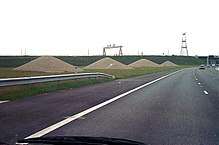Ferrybridge Henge
Ferrybridge Henge is a Neolithic henge near Ferrybridge, West Yorkshire (grid reference SE47462424).[1] It is close to the A1 and M62 and Ferrybridge power station.[2] Ferrybridge Henge is the furthest south of Yorkshire's henges, and is the only one in West Yorkshire.[3] The site is of national importance and is protected from unauthorised change as a Scheduled Ancient Monument;[1] despite this it is under threat from ploughing.[1]

History

.jpg)
There was activity on the site before the current henge in the form of circular monuments and hengiform monuments dating from 3500 BC to 3000 BC.[3] Ferrybridge Henge dates from 3000 BC to 2500 BC.[3] Around 2000 BC–1500 BC, during the early Bronze Age, barrow burials were performed on the site. The inhumations were discovered with grave goods such as ceramic pots and flint tools.[3] The area was probably abandoned from about 1500 BC to 500 BC when there was some reoccupation by Iron Age farmers.[3] The henge was not cultivated and may have been retained as a shrine for the Iron Age people of the area and later during the Romano-British period.[3] An Iron Age sword scabbard was discovered in the inner henge ditch as well as a Roman coin.[1][3] That burials continued in the area around the henge in the Saxon period despite the presence of a Christian cemetery nearby has been taken as evidence of pagan beliefs prevailing in the area.[3] Ferrybridge Henge and its surrounding area was used as farmland during the medieval period.[3]
The site was excavated by West Yorkshire Archaeological Services in 1991.[1] In 2007 a suspected extension of the henge was unearthed near Pontefract. The site consists of a field system and drainage ditches thought to date to the Iron Age or Romano-British periods. It was discovered when archaeologists were investigating a site intended for the construction of a row of houses; once the archaeological survey was complete, the construction went ahead.[2]
Layout
Ferrybridge Henge is a circular site and is about 180 metres (590 ft) in diameter.[4] The henge is surrounded by two ditches and a bank. The inner ditch is 10 metres (33 ft) wide and 2.5 metres (8.2 ft) deep. There is a 15-metre (49 ft) wide berm between the inner ditch and a 15-metre (49 ft) wide limestone bank. Separating the bank from the outer ditch is another berm, also 15 metres (49 ft) wide; the outer ditch is 12 metres (39 ft) wide and 1.5 metres (4.9 ft) deep.[1] This layout is typical of other henges.[3] The site has two entrances, one in the north east and one in the south west.[1]
References
- Historic England. "Ferrybridge Henge (54454)". PastScape. Retrieved 2 August 2016.
- "Ferrybridge Henge extension discovered in West Yorkshire". Culture24.org.uk. 30 August 2007. Retrieved 22 November 2009.
- Ian Roberts. "Ferrybridge ritual landscape" (PDF). West Yorkshire Archaeological Services. Archived from the original (PDF) on 25 September 2006. Retrieved 4 July 2008.
- Castleden (1992), p. 258.
Bibliography
- Castleden, Rodney (1992). Neolithic Britain: New Stone Age Sites of England, Scotland, and Wales. Routledge. ISBN 0-415-05845-7.
Further reading
- Riley, D.N., 1980. Recent air photographs of Duggleby Howe and the Ferrybridge henge, Yorkshire Archaeological Journal 52: pp 174–178
- Roberts, I. (ed.). 2005. Ferrybridge Henge: The Ritual Landscape. Leeds: West Yorkshire Archaeological Services.